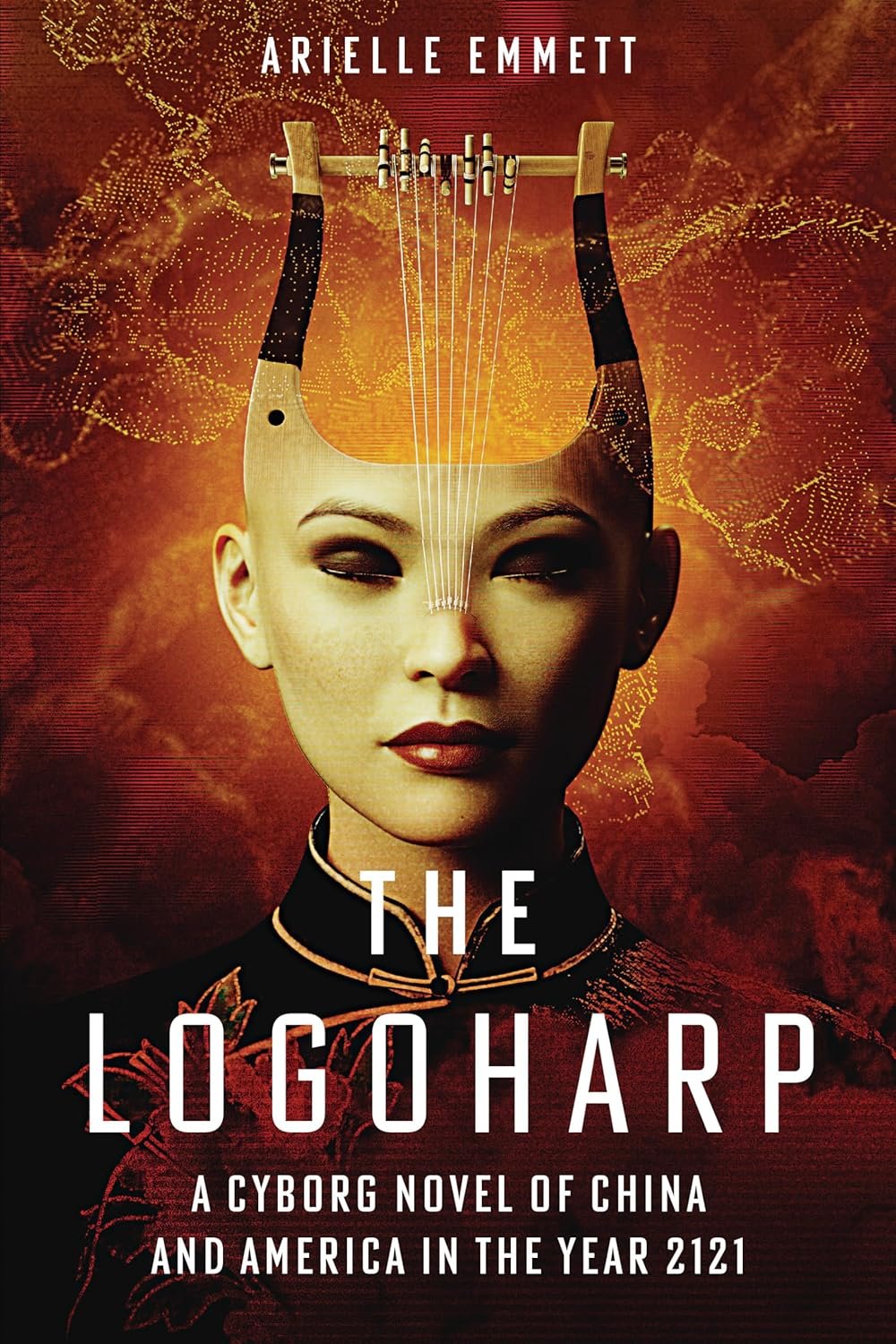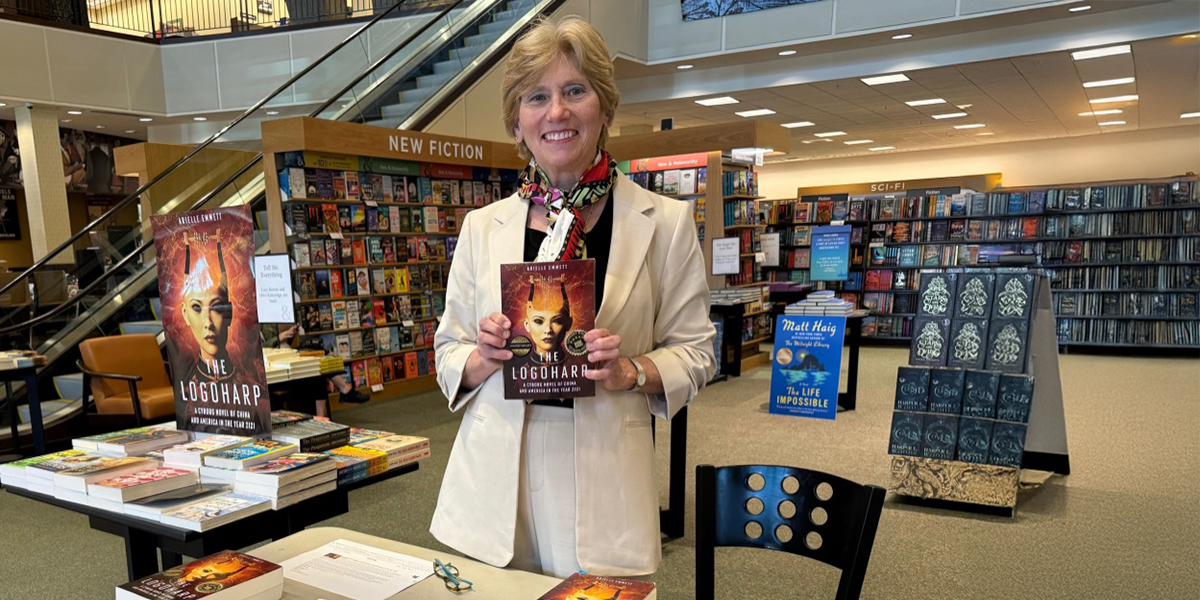A Thought-Provoking Conversation on Media, Technology, and the Power of Storytelling
Arielle S. Emmett discusses her debut novel The Logoharp, blending science fiction with journalism, exploring disinformation, AI-driven media, and cultural influences that shape narratives in a dystopian yet eerily familiar future.
Arielle S. Emmett is no stranger to the power of storytelling, whether through journalism or fiction. With a distinguished career spanning continents and disciplines, she has reported from East Asia, Africa, and beyond, bringing a sharp analytical lens to global affairs. As a journalist, her work has graced the pages of Smithsonian Air & Space, Mother Jones, The Scientist, and numerous other esteemed publications. Now, with her debut science fiction novel The Logoharp, she ventures into a speculative future where media manipulation, artificial intelligence, and political intrigue intertwine in unsettling ways.
In our conversation, Emmett offers a glimpse into the creative and intellectual forces that shaped The Logoharp. She draws from her deep well of experience—years of investigative journalism, a life lived across cultures, and a profound understanding of shifting global narratives. Her protagonist, Naomi, a journalist-turned-cybernetic media agent, embodies the ethical dilemmas of a world where information is both a tool and a weapon. Emmett’s reflections on truth, disinformation, and the evolution of media resonate powerfully in our own era, making her novel not only a gripping tale of the future but also a mirror to the present.
Beyond the novel’s thrilling premise, Emmett discusses the intersection of fact and fiction, the challenges of world-building, and the responsibility of writers to engage with complex, cross-cultural themes. Her insights reveal a writer unafraid to wrestle with the big questions—about technology, politics, and the human condition. In this interview, she shares her journey, the inspirations behind The Logoharp, and her thoughts on where science fiction, and perhaps the world itself, might be heading.
A gripping exploration of media’s evolving role, The Logoharp is a bold, insightful, and unsettlingly plausible vision of the future.
What inspired you to blend science fiction with elements of your journalistic background in The Logoharp?
Our global media landscape has changed radically in the last decades, perhaps as much as technological advancements and AI have changed us.
With a few rare exceptions, news organizations no longer act as independent monitors of power; nor do most emphasize meticulous fact checking and presentation of multiple perspectives. Instead virtually all news is channelized according to an agenda, much of it driven by partisan media bosses who build their economic models based on the specific tastes, preferences and values of targeted audiences.
Watching all of this happen during my long career as a science and international journalist, I envisioned a near-future heroine, Naomi, who “writes the future” on behalf of a global power (in this case, China) by seeking “the truth of probable outcomes.” In many ways, Naomi is mimicking the way journalists today frame and “predict” the very likely direction of near-term political and social events. Naomi’s becomes only half-human, a biomechanically enhanced “Reverse Journalist” cyborg reporter for China. She’s equipped with a neural instrument, the “Logoharp,” which doubles the size of her brain and allows her to speak and broadcast in 104 world languages. She’s driven by voices she hears in her AI-infused Logoharp, which filters and directs conversation and instructions from the State, but also from signal sources she can’t readily identify. Naomi then “reports the future” to the masses, as though it has already happened—and then it does. Confusion and incredulity result. But eventually the masses come to accept the reality she creates. This, to me, speaks to our media landscape today with its polarizing and often tragic results.
How do you think your extensive travel and experience in diverse cultures have influenced your writing?
I’ve now lived, reported and taught in Europe, Taiwan, Beijing, Hong Kong, parts of Indonesia, and, more recently, Nairobi, Kenya on a Fulbright Scholarship studying the Chinese presence in East Africa. Obviously just living in these countries, absorbing the literature and close friendships I’ve made produces insights, contradictions and many questions. I guess I’ve been encouraged (forced?) to understand cross-cultural perspectives very different from my own. The most jarring differences were encountered in China and Taiwan over many decades. It helped that I learned Mandarin Chinese in college and continued studying throughout my career. But overall, travel in multiple countries helped broaden my awareness of subject matter. The stories we rarely tell, and the ones we encounter accidentally, are those that interest me most. In The Logoharp I tried to incorporate Chinese phrases and terms of art to make Naomi’s world more authentic.
“The stories we rarely tell, and the ones we encounter accidentally, are those that interest me most.” – Arielle S. Emmett
Can you share your process for creating the futuristic world in The Logoharp? What was the most challenging aspect?
The futuristic world I built over a period of 12 years (really!) came to me in dreams, shards of autobiography, especially in the early parts of the novel, and, of course, distinct memories of characters I encountered in Taiwan, China and Hong Kong. Naomi, my heroine, was probably the most challenging character of all. The Logoharp’s main character, was the most challenging. In this story, she starts as a vulnerable American journalist and morphs into an AI-driven media propagandist for China who eventually rebels. Why would she do this? She lives in a severely weakened “Ameriguo” in the 22nd century. Betrayed by a young lover, she believes that “Mother Country” (China), the dominant global power, will ensure peace and a harmonious existence for a troubled planet—and a glorious career in media for herself. Aside from Naomi, some of the physical transport scenes – specifically the underseas luges enabling Naomi and her lover Marco to cross the Pacific at near hypersonic speeds—came to me from research I did while writing for Smithsonian Air & Space, The Bent, and other magazines. The world I created to describe the ice sleighs (cryo-pods) carrying “the dreaming dead” in Harbin came from actual visits to Manchuria in 2016 during the International Ice Festival. I also recall a short story written by my late mother, Nathalie Donnet, a teacher and excellent theatrical director. In her story she described how our grandparents were “preserved” in glass coffins for all to see. And they were still alive! Her way of suggesting how society treats the elderly. I readily “stole” that idea. So there were many sources to build this world, including articles I wrote on the Chinese space program, especially the lunar missions. In terms of “Life Clocks,” Fritz Lang’s Metropolis was another inspiration.
How do you navigate the complex themes of disinformation and truth in your work?
I think you have to read The Logoharp to get answers to this question. In some instances I parodied actual news events that were so absurd and horrific that they were funny in the retelling. In other instances I made up stuff based on Chinese, American, and North Korean witchhunts. Naomi’s attitudes toward “truth” and even “truthiness” are complex; she’s by no means a demonic character; she’s trying to do the right thing, and the multiple voices she hears in her Logoharp confuse her at times. Also, her algorithmic evaluation of political scenarios and outcomes always contains some “grain of future truth.” She reassures herself that she’s broadcasting appropriate reports…until she’s not.
Given your experience with both journalism and fiction, how do you balance fact-based writing with imaginative storytelling?
I’m not sure I “balanced” anything. I’ve always loved fact-based writing, but imaginative storytelling is a whole other skill, aka “altitude of mind.” In my case, I had to free up my imagination, to trust it after years of being a “fact head.” I had to uncover the emotions and yes, the pain of trying to reconcile what one “should do” given the facts of our society, our identity, our gifts (our lack of fame!) and what one “must do” to honor onself, to make sense of why we’re here. I can honestly say that “dreaming the language” of The Logoharp allowed me to write it, to free up the more constrained journalistic sides of my training. I also believe that cinema had a big effect on the structure of the narrative. A lot of readers have told me, “This is a movie!” which surprised me at first. I thought I was writing a novel.
What role do you believe science fiction plays in addressing contemporary political and social issues?
A big role. I don’t think most science fiction I read today, especially Chinese science fiction, “wants” or can address contemporary political issues a direct way. Multiple reasons, but one of them is China’s criteria for censorship. There are some notable exceptions, of course: Liu Cixin’s The Three-Body Problem, an incredible work of imagination, briefly addresses the devastating effects of China’s Cultural Revolution. Many other Chinese science fiction writers find solace in ghost stories, solipsism, ancestor worship, sleights of mind, time warps, and of course, alien invasions. In the Western sci-fi world, novels like Octavia Butler’s Kindred, for example, or Paolo Bacigalupi’s The Windup Girl, Adam Johnson’s The Orphan Master’s Son, and William Gibson’s work have important political and dystopic themes. But I don’t know where all of it is heading. I can only imagine a science fiction that addresses both human frailty along with the evolving mastery of technology and AI. What will the intersection of the two bring to our societies of the near future? And how will we foil the villains?
What advice would you give to other writers who are interested in tackling complex, cross-cultural topics in their work?
Spend time in the countries and cultures you write about. Get to know the language and the people. Otherwise, it’s “true fakery” or “fake news.” The smartest readers will know the difference.
EDITOR’S CHOICE
Arielle Emmett delivers a bold, thought-provoking debut—brilliantly imaginative, emotionally resonant, and richly layered with futuristic and political depth.



